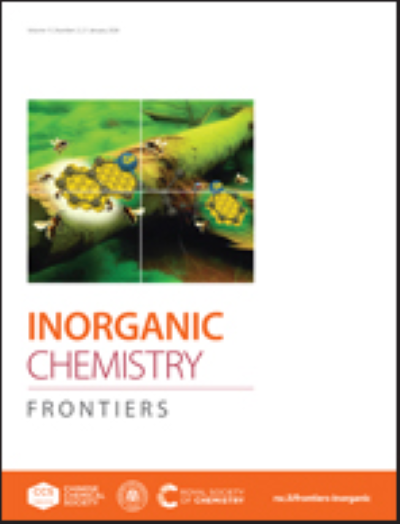金属有机框架中电子传递链激发的光电二极管样结在光催化中的定向多电子转移
IF 6.4
1区 化学
Q1 CHEMISTRY, INORGANIC & NUCLEAR
引用次数: 0
摘要
利用人工系统模拟电子传递链(ETC)棘轮状的多电子传递,对有机化合物施加厌氧反硝化和好氧氧化双模式,以生产高附加值精细化学品是非常必要的。但生物结构的极端复杂性阻碍了它们的直接模仿。本文报道了一种新的连续定向光诱导电子转移(PET)方法,以金属-有机骨架(MOF)为平台,采用溶剂辅助配体结合(SALI)方法将羧酸配位末端修饰的吩噻嗪(PTH)配体引入到铁卟啉PCN−222(Fe)中,模拟了天然酶的ETC过程。给电子(D) PTH部分和电子接受(A)铁卟啉在空间上被绝缘体状的高极性Zr−羧酸盐簇隔开。这种D−A结促进了类似光电二极管的定向电子从PTH转移到铁卟啉,从而防止了反向电子转移。与邻近的铁卟啉相比,PTH基序的局部过量分布有利于连续的电子注入。这些优点使得PTH@PCN−222(Fe)在N2中还原硝基芳烃和在O2中氧化苄胺的光催化性能比均相模式更高效。飞秒瞬态吸收(fs-TA)在PTH@PCN−222(Fe)内显示出比其他同类材料更有效的框架内光诱导电子转移(PET),进一步表明了这种生物启发超分子策略的优越性。本文章由计算机程序翻译,如有差异,请以英文原文为准。
Electron transport chain-inspired photodiode-like junction in metal-organic framework for directional multi-electron transfer in photocatalysis†
It is highly desirable to mimic the ratchet-like multi-electron transfer of the electron transport chain (ETC) by artificial systems and impose dual-mode anaerobic denitrification and aerobic oxidation on organic compounds to produce value-added fine chemicals. But the extreme complexity of biological structures hampered their direct mimics. In this article, we report a new continuous and directional photoinduced-electron transfer (PET) method to mimic the ETC process of natural enzymes using metal-organic framework (MOF) as the platform, phenothiazine (PTH) ligand decorated with carboxylate coordination terminal was introduced into iron porphyrin PCN−222(Fe) by use of solvent-assisted ligand incorporation (SALI) process, electron-donating (D) PTH moiety and electron-accepting (A) iron porphyrin were spatially separated by the insulator-like high-polar Zr−carboxylate cluster. This D−A junction facilitated the photodiode-like directional electron transfer from PTH to the iron-porphyrin, thereby preventing back-electron transfer. The locally excessive distribution of PTH motifs, compared to neighboring iron-porphyrins, favored continuous electron injection. These advantages facilitated the more efficient photocatalytic performance of PTH@PCN−222(Fe) in the reduction of nitroarenes in N2 and the oxidation of benzylamines in O2 compared with the homogeneous mode. Femtosecond transient absorption (fs-TA) demonstrated more efficient intra-framework photoinduced electron transfer (PET) within PTH@PCN−222(Fe) compared to other counterparts, further indicating the superiority of this bioinspired supramolecular strategy.
求助全文
通过发布文献求助,成功后即可免费获取论文全文。
去求助
来源期刊

Inorganic Chemistry Frontiers
CHEMISTRY, INORGANIC & NUCLEAR-
CiteScore
10.40
自引率
7.10%
发文量
587
审稿时长
1.2 months
期刊介绍:
The international, high quality journal for interdisciplinary research between inorganic chemistry and related subjects
 求助内容:
求助内容: 应助结果提醒方式:
应助结果提醒方式:


